Sustainability through the kaleidoscope
Since the turn of the new millennium sustainability has been an omnipresent buzzword in the world of design. But what does actual sustainable design look like? UID’s two new professors in design for sustainability, Danielle Wilde and Cindy Kohtala, paint a kaleidoscopic picture, focusing on bottom-up movements and the inclusion of marginalized voices, rather than silver bullet solutions.
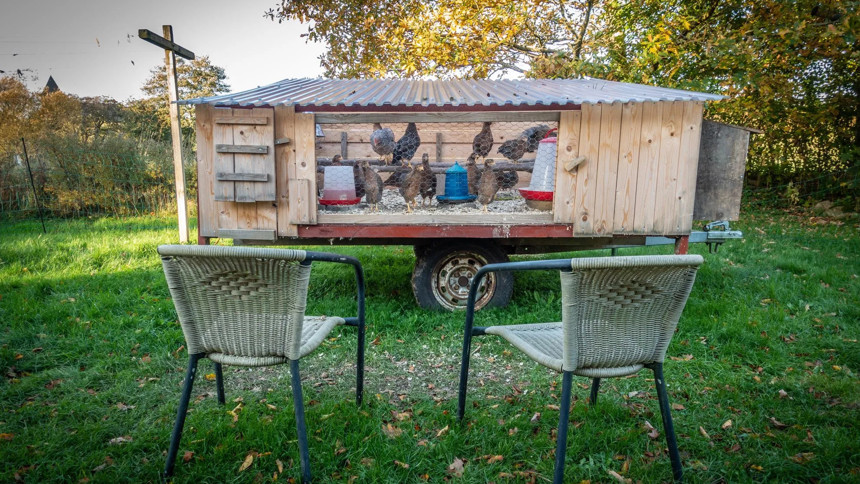
Chook TV shows the casual viewing set up of the new mobile chicken coop at Solskin organic and biodynamic farm, in Christiansfeld, Kolding, Denmark.
Image:Marcus RonaldsWithout doubt, humankind is facing unparalleled challenges relating to climate change and ecosystem collapse. The verdict from the Intergovernmental Panel on Climate Change (IPCC) is clear. We must urgently change how we live and eat, our material and energy interactions, if we want a liveable and sustainable future for all.
Design research is unique in its ability to embrace diverse perspectives
Danielle Wilde, Professor in Design for Sustainability at UID
While the notion of sustainable design may have been watered down by corporate forces using it as a handy label to slap on their products, many designers and design researchers continue to explore transformative ways of shifting our global society towards sustainable ways of life. To initiate lasting change, Danielle Wilde believes we need to create new spaces for diverse voices and perspectives, allowing these actors not just to be heard but to become real agents of change. This includes nonhuman actors, such as animals, the environment, and even the planet.
“Design research is unique in its ability to embrace diverse perspectives, while also recognizing that the individual experience is complex and intersectional. It's not just that I come as a woman and experience life. I'm a woman, I'm a foreigner in Sweden, I’m a motorcycle enthusiast, I'm a whole lot of different things. All these different things help to influence how I experience the world. What design research methods can do is create space to allow the full complexity of all the voices around the table to be heard, especially voices that are often marginalized”, says Danielle Wilde.
Controlling the means of digital production
Heading northeast across the Pacific, from Danielle’s home country of Australia, we end up in Cindy Kohtala’s native Canada – the province of Alberta to be more precise. Growing up on a farm, she was raised with a do-it-yourself outlook on life, routinely assisting her parents with the upkeep around the farm. To this day, the smell of fresh sawdust brings her back to the farm woodshed where she used to craft her own toys.
Early on, I became interested in the idea of people who were designing things but weren't trained designers
Cindy Kohtala, Professor in Design for Sustainability at UID
It wasn’t all play though. She also learned to repair furniture at a very young age. Fittingly, her eventual academic transition towards sustainable design came via the making of furniture from reclaimed items. Cindy’s thinking around circularity and sustainability is still informed by the values connected to resource preservation and organic crafting instilled in her as a child. As a young researcher, however, she would start to broaden her interests from hacking away at pieces of wood to computer hacking. More precisely, she began to examine local computer hacking communities hoping to democratize the means of digital production.
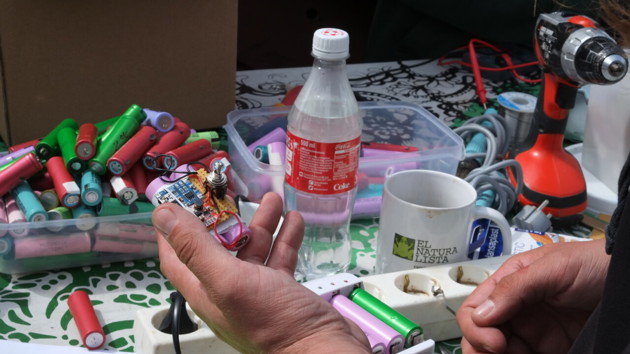
Community powerbank workshop in Helsinki. Sustainability oriented activist groups often host workshops to encourage learning about issues hands-on. Here they are taking lithium batteries from discarded laptops and teaching people how to wire them together to create USB chargers.
ImageCindy Kohtala“I'm not a coder myself, I don't do software. But I'm interested in when it mixes with material things. Early on, I became interested in the idea of people who were designing things but weren't trained designers. I’m curious about hackers working with open design, especially when it’s connected to the creation of physical products. Today, my research focus is on everyday design in material peer production, especially do-it-yourself (DIY) makers who design, invent and innovate in fab labs and makerspaces. I’m particularly interested in how sustainability plays a role in these makers’ techno-utopias”, says Cindy Kohtala.
When the patents for the first 3D-printers expired, ordinary people started to get access to these uniquely versatile tools, enabling local tech workshops to do small scale digital fabrication. Today, people have far greater opportunities to participate in design and technology, with real access to powerful open-source tools and knowledge. Cindy’s research explores the ways these tech subcultures could lead an industrial transition, bringing forth alternatives to mass production and consumption that are participatory, local and distributed.
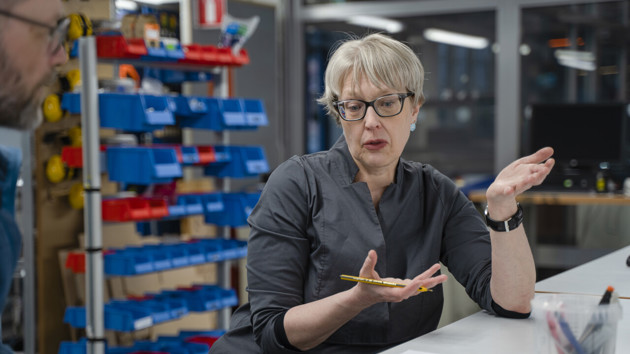
Cindy Kohtala in the UID workshops.
ImageMattias Pettersson“These makers are trying to democratize design and technology. At the core of the movements, we find a communal aspect where all of society is invited to become more tech literate and gain access to digital manufacturing technologies. In my work, I set up dialogues examining the sustainability impacts of these new practices and identify opportunities for material circularity and community resilience”, says Cindy Kohtala.
Food for change
Food is at the essence of the human experience. It is the richest, most intimate and regular material interaction that we engage in. Food and food systems also have far-reaching consequences for long-term sustainability, on the human as well as the planetary level. In her research, Danielle Wilde explores what policies, technologies, practices and relationships are needed for the food system to be just. She believes that to create real change, we need to start seeing food systems and food production through a more-than-human lens, offering perspectives beyond the human experience.
“My research brings focus to food as a multispecies concern, to uncover possibilities for transforming our values and material practices. Our food system impacts all 17 UN Global Goals and all nine planetary boundaries that we need to stay within if we hope to have a liveable planet. Yet food and eating practices are situated and personal in experience. Using food to approach the challenge of transforming systemic practices opens up radically new ways of thinking. I invite people from across society to use food as a tool for thinking through all of their senses, to reconnect our natures and our cultures, and transform the ways that we live in society, so that our material interactions can be edible, sustainable, regenerating, even delicious”, says Danielle Wilde.
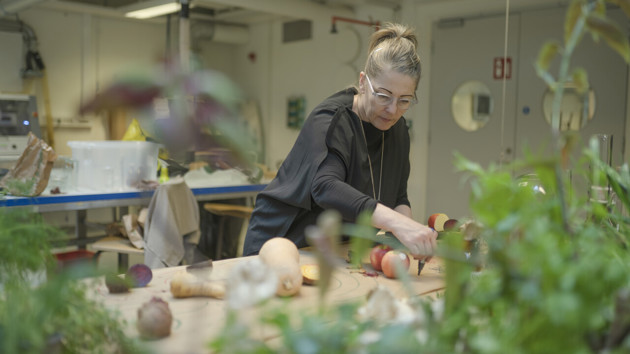
Danielle Wilde exploring food as an avenue towards sustainable ways of living.
ImageMattias PetterssonDanielle’s research palette sees her attempting to initiate change in distinctively different ways. With food as the common thread, she works with a dozen European cities, prototyping change at scale, to work out how the cities might modify their food systems to be more sustainable. At the same time, she believes that lasting change must begin with the individual, prompting her to look at food practices in homes and what change-making could look like in households – hoping to answer the question of how, for example, global sustainability reports can be translated into actionable advice for people in their everyday lives.
We need system change, but that system can't simply be imposed on people
Danielle Wilde, Professor in Design for Sustainability at UID
“We need to empower people on the individual level. If we don't have bottom-up pressure, then any top-down efforts simply won't work. We need system change, but that system can't simply be imposed on people. So, part of my work in this area is bringing civil society actors together to negotiate what needs to happen and then supporting them to negotiate with the municipalities”, says Danielle Wilde.
Beyond the personal experience, Danielle’s research zooms in further to examine the trillions of microbes living in the gut. Science and medicine continue to struggle with gut diseases. 25 percent of people on the planet will experience a chronic gut disease in their lifetime. Here, Danielle is trying to work out how design could assist in supporting people, through participatory and experimental methods, to develop new ways of envisioning human microbiome harmony so that they can live the challenges that they're experiencing with their gut in different ways.
Towards the pluriverse
Clearly, hacker culture and gut microbiome seem ultimately divergent academic focuses at first glance. However, through design research they can both become fertile ground for changemaking. Utilizing experimental and participatory methods, Cindy Kohtala and Danielle Wilde are both able to create inclusive frameworks for imagining new futures by allowing multiple voices to be heard.
“What is great about design research is that it uses a lot of different methods to bring different actors together to reflect in different ways, often using their bodies, manipulating objects, thinking through moving and making and doing, so that the ways that people are reflecting about things can really be enriched by engaging all of their senses in the process”, says Danielle Wilde.
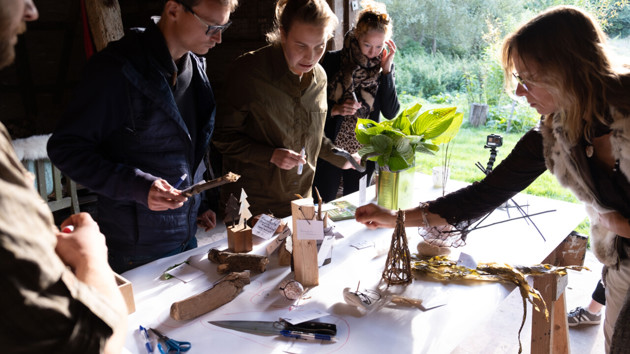
Creating a forest-based library of forage-able foods. Stakeholders using tangibles collected from a barn in the forest to conduct a stakeholder mapping exercise. The library-to-be is situated in Stenderup Midtskov, in Kolding, Denmark, and is part of the Fusilli project.
ImageDanielle WildeThrough practice-based design research, Cindy and Danielle unearth perspectives and imaginaries that might help guide us towards original ways of transforming human ways of living to become more sustainable. Their hope is that by stimulating participatory, bottom-up design and sustainability activism, ordinary people can become empowered to take an active part in how technology and food systems are allowed to shape us, our societies and the planet going forward.
An ever-accelerating materialism has put humanity on a seemingly inevitable collision course with our planet's ecosystems. Can design, which helped get us into this mess, respond differently to the challenges of global ecological, social, economic and cultural sustainability going forward? The embracing of a pluriverse of experiences and ideas, a world in which many worlds fit, seems a promising starting point.